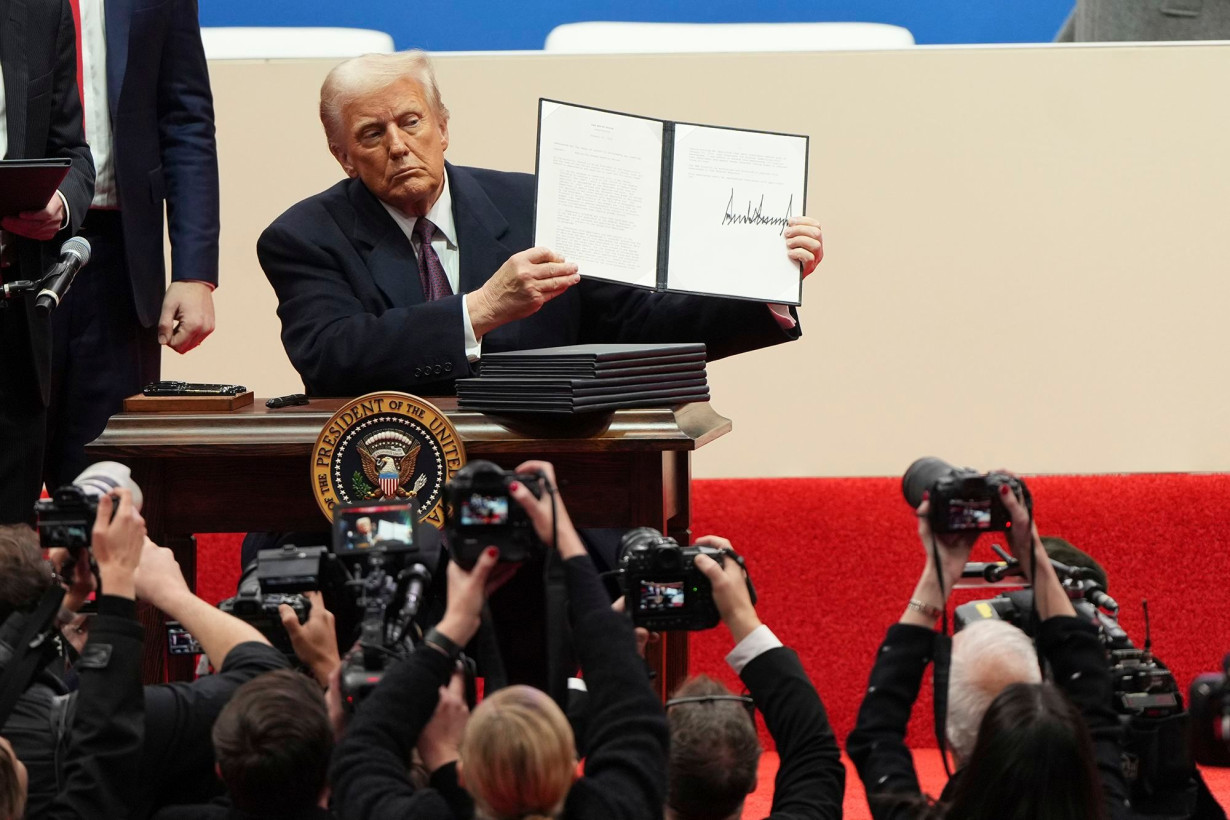(CNN) — It was no surprise when President Donald Trump this week issued a memorandum to the heads of federal departments and agencies, essentially directing them to get their employees back to the office full-time.
Among other things, soon after the presidential election, Elon Musk and Vivek Ramaswamy, who at the time were both slated to run Trump’s newly created Department of Government Efficiency, signaled that having a full-time return-to-office mandate was an invitation for many to quit.
“Requiring federal employees to come to the office five days a week would result in a wave of voluntary terminations that we welcome,” they wrote in an op-ed in the Wall Street Journal.
In fiscal year 2023, 43% of civilian federal workers engaged in telework on a “routine or situational” basis, according to a December report from the US Office of Personnel Management.
But for practical, financial and other reasons, implementing Trump’s directive could be more complicated and time-consuming than assumed.
The upshot? “It is reasonable to expect that a significant share of federal workers whose jobs can be done remotely will continue to work at least a few days a week outside of an official federal site [or] office over the next four years,” said government workplace expert Mika Cross, who has implemented several federal government-wide human capital policy and workplace initiatives.
Trump’s memorandum
The president’s directive states: “Heads of all departments and agencies in the executive branch of Government shall, as soon as practicable, take all necessary steps to terminate remote work arrangements and require employees to return to work in-person at their respective duty stations on a full-time basis, provided that the department and agency heads shall make exemptions they deem necessary.”
The language isn’t explicit about whether the order pertains simply to the estimated 10% of federal civilian workers who work remotely full-time — which is roughly 228,000 employees as of May 2024, according to the Office of Management and Budget. Or if it also applies to federal workers who have an approved hybrid schedule — teleworking for some period of every week and working on site for the rest.
“As I read it now, the [memorandum] applies to federal offices across the entire country, not just in Washington, DC. But it specifies ‘remote work’ and not ‘telework.’ I wonder if it was intended to apply to both work arrangements or just remote work,” Cross said.
New guidance from OPM, first obtained by CNN’s Jamie Gangel, seems to imply the new mandate will apply to both types of arrangements. “The only way to get employees back to the office is to adopt a centralized policy requiring return-to-work for all agencies across the federal government,” the guidance states.
It goes on to say that by no later than 5 p.m. ET Friday, “The agency head or acting agency head should revise their agency’s telework policy issued under 5 U.S.C. § 6502(a)(1)(A) to state that eligible employees must work full time at their respective duty stations unless excused due to a disability, qualifying medical condition, or other compelling reason certified by the agency head and the employee’s supervisor.”
While the new mandate will affect many across the federal workforce, Cross believes the effects could be “devastating” for certain demographics, such as employees who are the spouses of military and foreign service personnel, since they have to live where their spouse is assigned. It remains to be seen if that type of situation might be considered a qualifying exemption.
Costs and practical issues of getting workers on site
Cross notes that implementing this directive for full-time remote federal workers and those who have approved telework arrangements won’t be easy.
“The directive mandates that all executive branch departments and agencies end remote work arrangements and require employees to return to their respective duty stations. However, by definition, [fully remote workers’] official worksite is their home office location. So they do not have offices to return to,” Cross said.
Since remote workers are around the country, the agencies would have to find an office near them to report to or require them to move to be close to one. Both efforts could increase federal costs.
Travel: If a fully remote worker has to commute to a new office, they would be eligible for transit subsidies. Or if the office is more than 50 miles from their home, they might get temporary duty pay for transportation, lodging and per diem expenses. But temporary duty pay may be less of a concern, since the OPM guidance states that “If an employee’s official duty station is more than 50 miles from any existing agency office, the agency should take steps to move the employee’s duty station to the most appropriate agency office based on the employee’s duties and job function.” That sounds like it might require relocating a person’s job. If so, will the person move?
Pay: If a remote worker has to relocate to an area with a higher cost of living — such as Washington, DC — their locality pay would have to be adjusted. For example, one given role in DC pays almost $19,000 more than the same role in Kentucky or Maine, Cross said. Another pays $26,000 more.
Hiring costs: Should highly skilled, experienced federal workers who are working remotely full-time or teleworking part of the week decide to quit rather than comply with the new mandate, the department or agency would incur costs to hire their replacements.
Potential legal obstacles
Trump’s directive ended with this line: “This memorandum shall be implemented consistent with applicable law.”
To the American Federation of Government Employees, that means the mandate can’t violate contractual obligations negotiated by the union. “[It] would mean honoring any hybrid work arrangements detailed in our ratified contracts. We’ll obviously be watching to see how the order is implemented and will respond accordingly if needed,” said spokesman Tim Kauffman.
A legal fight over those contracts may be in the offing if Trump follows through on statements he made during his first post-election news conference in December. He attacked an agreement that the Social Security Administration struck with the AFGE, allowing the agency’s staffers to continue teleworking into 2029.
“If people don’t come back to work, come back into the office, they’re going to be dismissed,” Trump said. He added that his administration is “going to obviously be in court to stop” the agreement.
Risks to engagement and retention
Quite apart from all the logistical, legal and financial considerations, issuing a blanket RTO mandate for federal workers may create other concerns.
The pros and cons of remote work and hybrid arrangements have been looked at closely ever since so many organizations had to rely on them during the pandemic.
While any arrangement — fully remote, hybrid, or full-time on site — can have its drawbacks if not managed well, many studies show that offering flexible work is a key way to attract, engage and retain talent while also preserving institutional knowledge. And the federal government has to compete with the private sector to find qualified workers.
In a 2021 report, the OPM cited several advantages of having telework options for those whose work can be done remotely. They include helping an agency “acquire the knowledge needed for difficult-to-hire, mission-critical talent or hard-to-find skill sets,” and “meet the demands of a changing workforce that demands more flexibility.”
One example of critical talent needed is in the area of technology. In congressional testimony before the House Oversight Committee last week, Cross noted that “there are 19 times more retirement-eligible workers over 50 than those under 30 in Federal IT positions.”
Workplace research firm Gallup, meanwhile, found last year that “93% of employees in remote-capable jobs prefer to work remotely at least some of their work week.” In addition, it found that “six in 10 exclusively remote employees say they are extremely likely to search for employment elsewhere if they are not allowed remote flexibility.”
Different studies assessing the impact of telework arrangements on productivity can use varied measures for productivity. But several find either a positive correlation or a neutral one.
The Bureau of Labor Statistics, for example, found that “total factor productivity” — output divided by total production inputs such as “workers, machinery and other capital, energy, materials, and services” — increased across 61 industries as remote work options increased.
Another study — a six-month randomized control trial conducted by work-from-home researcher Nicholas Bloom of Stanford University and two colleagues from The Chinese University of Hong Kong and Peking University — found that working from home two days a week did not damage employee performance, but it did boost their job satisfaction and reduced quit rates.
However Trump’s RTO mandate is implemented, and whatever its ramifications on federal workers, under the Telework Enhancement Act of 2010, federal agencies will still need to maintain a business continuity plan authorizing employees to telework during emergency situations or crises, such as a natural disaster.
The-CNN-Wire
™ & © 2025 Cable News Network, Inc., a Warner Bros. Discovery Company. All rights reserved.

 Trump has begun another trade war. Here's a timeline of how we got here
Trump has begun another trade war. Here's a timeline of how we got here
 Canada's leader laments lost friendship with US in town that sheltered stranded Americans after 9/11
Canada's leader laments lost friendship with US in town that sheltered stranded Americans after 9/11
 Chinese EV giant BYD's fourth-quarter profit leaps 73%
Chinese EV giant BYD's fourth-quarter profit leaps 73%
 You're an American in another land? Prepare to talk about the why and how of Trump 2.0
You're an American in another land? Prepare to talk about the why and how of Trump 2.0
 Chalk talk: Star power, top teams and No. 5 seeds headline the women's March Madness Sweet 16
Chalk talk: Star power, top teams and No. 5 seeds headline the women's March Madness Sweet 16
 Purdue returns to Sweet 16 with 76-62 win over McNeese in March Madness
Purdue returns to Sweet 16 with 76-62 win over McNeese in March Madness








